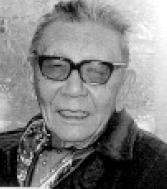(Died: February 4, 2002)
Geologist
Interests: Expanding Earth
Gorai was born in 1916, graduated from the Tokyo University of
Education and dedicated all his life to the study of
magmatism and earth evolution. He was one of the three
founding members of the Geological Collaboration
Association of Japan (CHIDANKEN). The paper on Gorai
Twin first appeared in a Japanese journal in 1947, and
petrologists in other parts of the world had to wait until
1951 when the paper was published in American
Mineralogist. The method enabled the distinction between
igneous and metamorphic granites, a topic of hot debates
in the 1940s to 1950s. In addition to his above classic
paper, Gorai also published another important paper in
1951, as the clear antithesis to the Bowen?s primary
basaltic magma theory, emphasizing the role of the
interaction of crustal material and mantle material in
the process of magma generation. In middle 1950s,
M. Gorai changed the idea of granite genesis from the
granitization of sedimentary rocks to mantle derivation
through his new study of Pb isotopes. He inaugurated
and developed the isotopic petrology laboratory in his
department, and made many pioneer and advanced
studies based on both Rb?Sr and Sm?Nd isotopic
systematics, opening a new generation of petrologists and
isotope geochemists.
M. Gorai?s first series of Japanese textbooks,
Petrogenesis of Igneous Rocks appeared in 1955-1958.
The books carried a series of ideas of magma generation
through mantle-crust interaction. These, and his
subsequent works encouraged many young Japanese
researchers. M. Gorai was in agreement with the
Masao Gorai
(1916-2002)
Gondwana Research (Gondwana Newsletter Section) V. 6, No. 4, pp. 938-939.
? 2003 International Association for Gondwana Research, Japan. GNL
Gondwana Research, V. 6, No. 4, 2003
939
Wegener?s continental drift theory, but disagreed to extend
it into further earlier times. He was inclined more towards
the concept of expanding earth, and considered this
responsible for the principal dispersion of the
supercontinent in the Cretaceous time. His textbooks after
the 1970s are based on the above idea.
In His Own Words
"I have been investigating the tectonic and enigmatic evolution of the Earth for the past twelve years. As a result I believe now that the most fundamental motive force responsible for such evolutional processes is the Earth's expansion, which might have happened through the inversion of super-dense phases deep in the Earth into ordinary molecular phases. The inversion may perhaps be the result of pressure decrease which is due to the secular decrease of G in the expanding universe. As an alternative, however, I would like to notice the problem of secular temperature increase deep in the Earth.
Through my study, I have been much inspired by several forerunners of the Earth's expansion hypothesis, especially by the excellent book of Dr. S. W. Carey, published in 1976."


